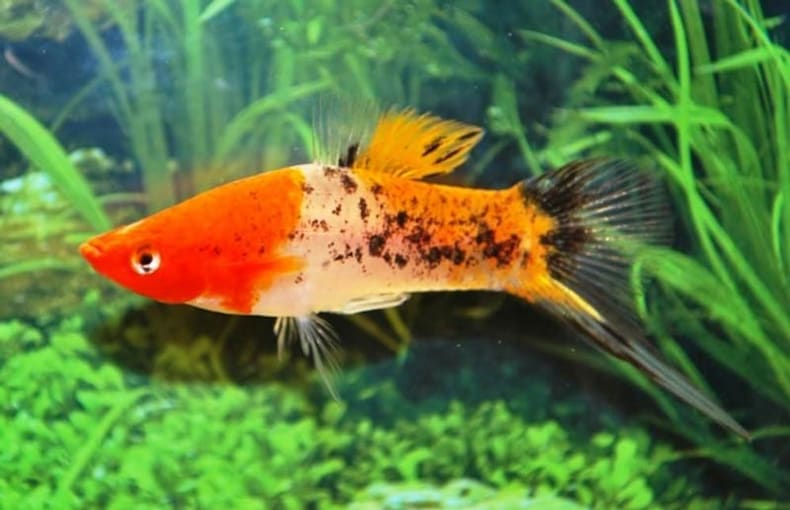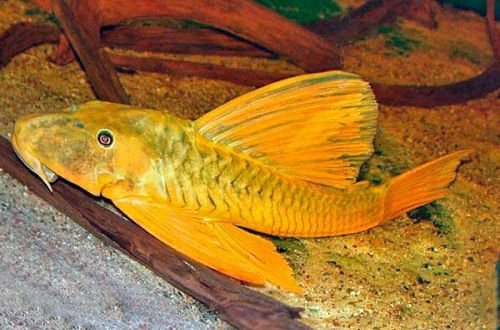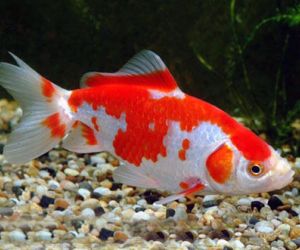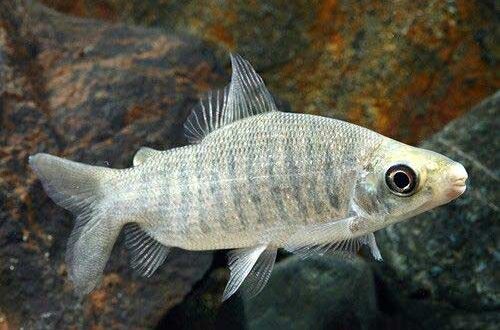
Swordsman Sanke
The Sanke swordsman, scientific name Xiphophorus hellerii (Koi Sanke breed), belongs to the Poeciliidae family. It is a breeding variety of the common Green Swordsman, it does not occur in nature. The name is borrowed from the ornamental carp Koi Sanke, which has a similar body color.

The coloration consists of a combination of red (orange) and white with irregularly shaped black specks that can merge into large spots with fuzzy “blurry” edges. The number and location of the flecks differs from fish to fish, creating an individual pattern.
There is another breed with a similar color – Calico Swordsman (Showa). It also has black spots on a red and white background, but differs in that the dark pigment is most pronounced in the back of the body and often completely stains the caudal peduncle.
It is worth noting that the differences are not so significant, so confusion with names is a typical situation. The absence of a reference population complicates identification. Depending on the breeder, the intensity of pigmentation varies. Sometimes it is almost impossible to distinguish the Swordsman Sanke from the Calico Swordsman.


Color features are characteristic of both sexes. Males can be distinguished by the presence of a characteristic “sword” on the caudal fin.
Brief information:
- The volume of the aquarium – from 100 liters.
- Temperature – 16-28°C
- Value pH — 7.0–8.0
- Water hardness – soft to high (10-30 dGH)
- Substrate type – any
- Lighting – moderate or bright
- Brackish water is permissible in a salt concentration of up to 15 g per 1 liter
- Water movement – light or moderate
- The size of the fish is 7–10 cm.
- Food – any food
- Temperament – peaceful
- Content alone, in pairs or in a group
Maintenance and care
It belongs to the number of unpretentious species that can adapt to various conditions of detention. The swordtail Sanke can live in a wide range of temperatures and hydrochemical values, including brackish water. Not picky about the choice of design.
Aquarium maintenance includes a standard set of procedures: weekly replacement of part of the water with fresh water, regular removal of organic waste (food residues, excrement), cleaning glass from plaque, equipment maintenance.
It is advisable to equip the aquarium with a lid to prevent the fish from accidentally jumping out. Thickets of floating plants will also serve as an obstacle.
Food. Accepts almost all types of food intended for aquarium fish. The basis of the daily diet can be dry foods in the form of flakes, granules. A good addition would be live or frozen food.
behavior and compatibility. Active friendly fish. They are peacefully disposed both towards relatives and other species. They get along well with non-aggressive fish of a comparable size.
When choosing tankmates, it is worth remembering that Swordtails can produce hybrid mixed offspring with other breeds and representatives of related species, for example, with Paecilia and Mollies.





